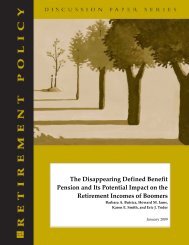View the entire report as a PDF - Tax Policy Center
View the entire report as a PDF - Tax Policy Center
View the entire report as a PDF - Tax Policy Center
You also want an ePaper? Increase the reach of your titles
YUMPU automatically turns print PDFs into web optimized ePapers that Google loves.
<br />
<br />
<br />
<br />
<br />
<br />
10<br />
effects of <strong>the</strong> tax reform plan included in Representative Paul Ryan’s (R-WI) Roadmap for<br />
America’s Future Act of 2010. Jim Nunns and Jeffrey Rohaly analyzed <strong>the</strong> revenue provisions<br />
in <strong>the</strong> Bipartisan <strong>Tax</strong> Fairness and Simplification Act of 2010, sponsored by Senators Ron<br />
Wyden (D-OR) and Judd Gregg (R-NH).<br />
<strong>Tax</strong> Expenditures<br />
As growing concern h<strong>as</strong> focused on <strong>the</strong> long-term budget problem, policy analysts have ques<br />
tioned <strong>the</strong> more than $1 trillion in annual revenues lost to tax expenditures—provisions in<br />
<strong>the</strong> tax law that allow a special exclusion, exemption, or deduction or provide a special tax<br />
credit, a preferential tax rate, or a deferral of tax liability. Many tax expenditures promote<br />
important social goals, but some may no longer serve a useful purpose or could be more effec<br />
tive if restructured.<br />
TPC analyzed <strong>the</strong> revenue and distributional impacts of tax expenditures in detail for<br />
both <strong>the</strong> president’s fiscal commission and <strong>the</strong> Domenici-Rivlin commission. In addition, TPC<br />
codirector Eric Toder, Benjamin Harris, and Ka<strong>the</strong>rine Lim cowrote a paper showing how <strong>the</strong><br />
three largest groups of tax expenditures—those for health care, saving, and owner-occupied<br />
housing—provide relatively larger benefits<br />
to high-income families than to low- and<br />
middle-income ones. In ano<strong>the</strong>r paper with<br />
Margery Austin Turner and Liza Getzinger<br />
of <strong>the</strong> Urban Institute’s <strong>Center</strong> on Metro<br />
politan Housing and Communities, Toder<br />
and Lim showed how changing <strong>the</strong> mort<br />
gage interest deduction to a credit could<br />
provide more benefits and a greater incen<br />
tive for low- and middle-income families<br />
to own homes. Finally, in “Government<br />
Spending Undercover: Spending Programs<br />
Administered by <strong>the</strong> IRS,” Toder and TPC<br />
affiliated scholar Lily Batchelder explained<br />
some of <strong>the</strong> problems with using <strong>the</strong> tax<br />
system for backdoor spending.<br />
Value-Added <strong>Tax</strong><br />
Eric Toder testifies before <strong>the</strong><br />
Senate Committee on Finance.<br />
The p<strong>as</strong>t year h<strong>as</strong> seen incre<strong>as</strong>ed discus<br />
sion of using a value-added tax (VAT) like<br />
those used in all o<strong>the</strong>r developed econo<br />
mies to help close America’s long-term<br />
budget gap. In “Effects of Imposing a





